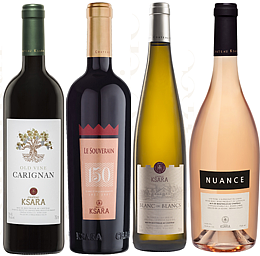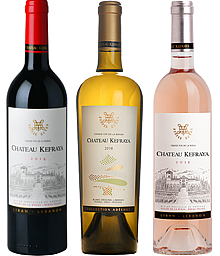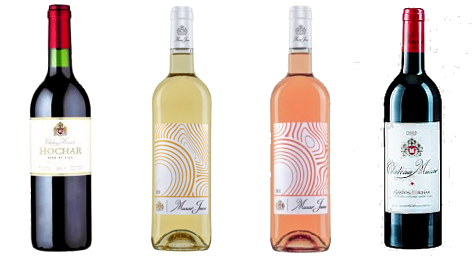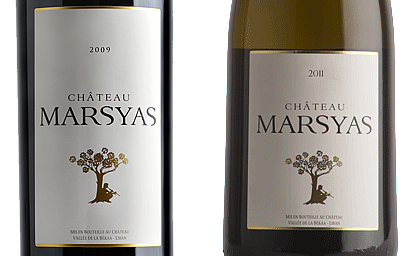The wines of Lebanon are renowned, particularly Château Musar, but how many of us know about wines from Syria. Paul McCarthy tells us more.
Syria
The Phoenicians first established wine-making in what is now Syria and it became an important part of the local culture. The country's wines were renowned around the world, with an annual wine festival normally being held in the town of As-Suwayda. The town was known by the ancient Greeks as Dionysias after their revered god of wine, Dionysus. However, the country's current and ongoing internal conflicts have not only stopped this festival from happening, but largely have curtailed wine-making in general.
Wine-making is mainly centred around the Latakia province. Vines are cultivated on the slopes of the Mediterranen-facing side of the Mount Bargylus range. The temperate climate here and fertile land, combined with long days of sunshine, provide the ideal location for vines and their grapes to flourish.
The region has not been the worst affected by the conflicts, but only one major wine producer is still functioning. The winery of Domaine De Bargylus is still making world-renowned wines, albeit with some major changes. It is owned and run by the Saadé family, who still manage operations but do not remain on the premises. Due to security reasons, they now have to oversee the day to day running of the business remotely from their base in Lebanon.
Before any wines are released, samples are sent to them for tasting and approval. The conflict has taken its toll on the vineyards, with some vines having been destroyed during skirmishes. Despite all the difficulties, wines from Domaine de Bargylus continue to be shipped around the world and have a deservedly high reputation.
If you do comes across wines from Syria, then they are well worth trying and their quality will surprise many who have never tasted them before. As Domaine de Bargylus is still functioning and exporting, look out for these 2 wines in particular.
Red – Bargylus Grand Vin De Syrie Rouge
NOSE: Aromas of black fruits and spices with a hint of mineral and truffle notes
PALATE: Big full bodied dark fruit flavours with soft tannins that last on the palate and end with a clean ,slighty minty, finish
FOOD PAIRING: Great on its own watching the sun set over the Mediterranean Sea, or with the meaty elements of a meze, dark meats (venison in particular), hard mature cheeses
SUMMARY: Made from a blend of Syrah, Merlot and Cabernet Sauvignon grapes. Expect to pay £25 to £35 a bottle. The wine is well worth spending the money on and available from some merchants.
White – Bargylus Grand Vin De Syrie Blanc
NOSE: Fresh soft fruits like peach and pear with hints of minerals
PALATE: Crisp and lemony with notes that remind you the grapes are grown overlooking the Mediterranean. The wine does soften and become more rounded with a little age
FOOD PAIRING: As an aperitif or with white fish, seafood, salads, young soft cheeses
SUMMARY: Made with a blend of Chardonnay and Sauvignon blanc grapes. Wine merchants are selling this wine for between £25 and £35 a bottle.
Lebanon
One of the hot spots for wine-making by the Phoenicians was Lebanon. Changes in cultures and wars have greatly influenced the wine industry over the years. The country's vineyards are mostly sited along the Bekaa Valley, which has the ideal temperate climate, fertile soil and lots of sunshine under which grapes flourish.
Modern wine-making traces its roots back to 1847 when Château Joseph Spath was established. It was followed in 1857 by Château Ksara after Jesuits had planted Cinsault vines from Algeria there. In 1868, a French engineer, Eugène François Brun, established Domaine des Tourelles. Others then followed including Gaston Hochar who established Château Musar in 1930.
Alongside important aspects of day to day life such as food, education and culture, the French rule between the two World Wars—In 1920, soon after the end of World War I, the League of Nations mandated that Lebanon would be administered by France following the Partition of the Ottoman Empire, until January 1944, when France agreed to transfer power to the Lebanese government, thus granting the territory independence—had a significant impact. This had a great influence on the wine making industry we see there today. Beirut became the place to go to before Civil War broke out in 1975. I have visited Beirut a few times since the war ended and seen for myself how the French years of administration are present in day to day life. I have also experienced the impact their immediate neighbours have on how people go about life. Since the war ended, lots of investment has gone into Lebanon. This has included investment in the wine industry which has not only recovered from the dark days of Civil War, but is flourishing with some excellent wine makers producing award-winning, world-class wines.
Many grape varieties are cultivated. The French influence is most evident with Cabernet Sauvignon, Merlot, Cinsault, Carignan and Grenache. Indigenous varieties such as Obaideh and Merwah are also grown.
Château Ksara is to this day the largest producer. They are followed by Château Kefraya. The most internationally known producer is Château Musar. Their flagship red has long been available in the UK through merchants and the well-established network of Lebanese Restaurants. It is also worth mentioning other more recently established houses such as that of the Saadé bothers, Château Marsyas.
Let us look at some of the wines these particular producers offer.
Château Ksara
Their current range consists of 17 red, white and rosé wines, an arak and two eaux de vie de vins. These cover easy day to day drinking wines through to far more complex wines. Prices vary accordingly. Here are details on 4 very different offerings.

Red – Old Vine Carignan
NOSE: Red berries with hint of spice
PALATE: A medium-bodied wine with soft fruit flavours and soft tannins. Light spice notes.
FOOD PAIRING: Light meats such as chicken and pork, soft white cheeses, white fish. Not one to enjoy with spicier food
SUMMARY: An OK day-to-day wine. Made solely from the Carignan grape. Merchant prices range from £8 to £12 a bottle.
Red — Le Souverain
NOSE: Blackberries and ripe dark plums with spice
PALATE: A full bodied wine that delivers a big long lasting dark berry flavour, tempered with tannins to give a rounded and balanced experience
FOOD PAIRING: Dark meats such as beef and venison, charcuterie and cured meats, works well with roast lamb, mature hard cheeses, lightly spiced and aromatic dishes, stews and casseroles, meze
SUMMARY: A serious complex wine to be savoured. Made by blending the Arinarnoa and Marselan grapes. Merchant prices range from £35 and upwards a bottle. Decant an hour before serving.
White — Blanc de Blancs
NOSE: Citrus zest mixed with hints of apricot and peach
PALATE: A refreshing well balanced wine, whose mix of soft fruit and citrus flavours make for a more complex wine as you work your way down the glass.
FOOD PAIRING: Light meats such as chicken and pork, soft white cheeses, white fish. Not one to enjoy with spicier food. Enjoyable though as an aperitif.
SUMMARY: An OK day-to-day wine. Made from a blend of Sauvignon, Sémillon and Chardonnay. Merchant prices range from £12 to £16 a bottle.
Rosé — Nuance
NOSE: Red berries, peach, pomegranate with hint of spice
PALATE: A medium bodied wine that delivers a range of flavours on the tongue. More complex than your average rosé.
FOOD PAIRING: Light meats such as chicken and pork, soft white cheeses, white fish. Not one to enjoy with spicier food
SUMMARY: Not an everyday drinking wine, but one to impress guests at a dinner party or in a restaurant if you are the host. A blended wine combining Malbec, Marselan and Vermentino grape varieties. Merchant prices range from £28 to £40 a bottle.
Château Kefraya
Château Kefraya has a 300 hectare wine estate on the Bekaa plain. Its vineyards extend along the foot of Mount Barouk, around 20 km south of the town of Chtaura. They produce 1.5 million bottles a year with a lot of their production shipped around the globe. Their wine range of 20 wines cover reds, whites and rosé. The range goes from everyday drinking wine up to the limited edition high end. Here are three examples of their everyday to mid range wine.

Red – Château Kefraya Red
NOSE: Combines cherry notes with spices, leather and vanilla
PALATE: A big full bodied wine with dark fruit flavours balanced well with soft tannins and light peppery tones
FOOD PAIRING: Dark meats such as beef and venison, mature hard cheeses. Lightly spiced and aromatic dishes, meze
SUMMARY: A big but gentle wine that should be opened an hour and decanted before serving. Made from a blend of Cabernet Sauvignon and Mourvèdre grapes. The wine is aged in oak for a minimum of 18 months and up to 24 months. Merchant prices range from £35 to £50 a bottle. A special wine to be savoured. I have enjoyed this wine a few times when in Beirut.
White – Château Kefraya “ADÉENNE”
NOSE: Ripe plums with orange blossom notes and orange peel
PALATE: A big warm fruit flavour with hints of citrus and spices
FOOD PAIRING: Light meats such as chicken, veal and pork, young white cheeses, salads, fish and sea food. Works well with cream sauces and is also a very pleasant drink on its own
SUMMARY: A very different wine that is made from indigenous grapes. It delivers an enjoyable Middle Eastern exotic flavour experience. The wine is a blend of Mekssessé, Obeidi and Merwah grapes, providing an aromatic, complex wine. You will pay £15 to £22 for this wine.
Rosé – Château Kefraya Rosé
NOSE: Light red berries with a fresh light citrus background
PALATE: Ripe red berries with a gentle acidity giving a fresh, clean finish. More complexity than you would expect from a rosé.
FOOD PAIRING: Light meats such as veal, chicken and pork, charcuterie, young white cheeses, salads, fish and sea food. Nice on its own
SUMMARY: A very good example of a rosé that has benefited from grapes grown in lots of sunshine. Made from a blend of Cinsault du Liban and Tempranillo. It can be bought from merchants between £12 and £18.
Château Musar
Gaston Hochar established his winery Château Musar in 1930 after returning to Lebanon from Bordeaux. The estate is located in Ghazir, which is 15 miles north of Beirut. Their grapes grow at around 3,300 ft above sea level in the sunny and fertile conditions found along the Bekaa valley.
His son Serge became the winemaker in 1959 after learning his craft at the University of Oenology in Bordeaux. Along with brother Ronald (who handled marketing and promotion) they had an international vision for the business. Their wine first gained international attention at the 1979 Bristol Wine Fair. The wine was such a stand out experience for those who tasted it at the fair, that it prompted the renowned wine critic and auctioneer, Michael Broadbent, to state it was “the discovery of the fair”.
Following this praise, the wine was exported around the world. I remember it being on the shelves of Oddbins and Harrods. Also it could be enjoyed in some of the Lebanese restaurants in London that started to gain popularity in the 1980s.
I first discovered the wine when buying it from Oddbins after a tasting. It was a revelation and the pleasant memories of drinking the first bottle with friends still remain. Over the years I often chose this wine when available in a restaurant or from Oddbins.
Initially the wine had an issue with some of the corks, resulting in an unpleasant corked wine. It led to rumours that it was a wine which did not travel well. Fortunately, I never had such an experience to taint my memories. The brothers, aware of the issue, sorted this out. They also evolved the wine over the years from the style, which I first experienced being big and robust but lacking finesse, to the wine we can drink today. It still has that big punch on the palate, but now also has complexity with a perfect balance between fruit and tannins, making for a wine that can compete with many of Bordeaux's finest.
Let us now look at this flagship wine as it is today, plus three of other wines from their range.

Red — Hochar Père et Fils
NOSE: Dark ripe berry fruits and fine pepper with a hint of spice
PALATE: The tannins help soften the rich fruit flavours to deliver a balanced taste with a slowly fading finish
FOOD PAIRING: Casseroles, roasted meats, tuna steaks and meze.
SUMMARY: Made from a blend of Cinsault, Grenache and Cabernet Sauvignon grapes. From initial maturation in cement vats, the wine is stored in French oak barrels to develop its characteristics for up to 9 months. Best decanted an hour before serving. Expect to pay £25 to £35 from a merchant.
White — Musar Jeune
NOSE: Passionfruit, apples, elderflower
PALATE: Fresh fruit with a gentle acidity and lemon peel
FOOD PAIRING: Enjoy it at 12ºC with grilled fish, herb-scented roast chicken, seafood salads and spicy oriental dishes
SUMMARY: The wine is unoaked. It is made from an French/Italian eclectic grape blending of Viognier, Vermentino, and Chardonnay. You will pay from £16 to £25 when buying from a merchant.
Rosé – Musar Rosé
NOSE: Raspberry, almonds and red apple skins
PALATE: Rounded soft fruit flavours, balanced with acidity and sweet almond overtones
FOOD PAIRING: Enjoy it at 12C with baked salmon, shellfish, roast pork or tomato-based pasta dishes.
SUMMARY: The wine is unoaked. It is stored for one year in cement vats before bottling. There is a grape blend of 85% Cinsault with 15% Mourvedre. £18 to £30 will get you a bottle from a merchant.
Red – Château Musar (where it all started)
NOSE: Ripe black berries, plum, spice and cigar box notes
PALATE: The wine delivers a big explosion of dark fruits and well balanced tannins that gently fade
FOOD PAIRING: Should be served at 18°C and works well with roasts, grills (especially lamb), casseroles, game, and mature cheeses. I once enjoyed it in a Budapest restaurant with a spicy fish stew.
SUMMARY: Made from a blend of Cabernet Sauvignon, Carignan and Cinsault grapes. The wine must be decanted at least an hour before serving. This is a serious wine and not for every day consumption. That is why you will pay merchants £50 and upwards into the hundreds for this very special wine.
Château Marsyas
For the final reviews of Lebanese wines we look at the Saadé family and their Château Marsyas operations. Brothers Karim & Sandro Saadé are taking their family wine making history to new levels. Using modern wine-making techniques and state of the art technologies, the brothers are producing wines of the highest quality. They are doing their part to get Lebanese wines recognised as being of international standard and not just ethnic curiosity value. Here are 2 wines that are worth checking out.

Red — Château Marsyas Rouge
NOSE: Black fruits and fine pepper with a hint of liquorice
PALATE: Tannins are well balanced with the punchy dark fruit flavours, delivering excellent full bodied flavour that has length with a freshness as it fades
FOOD PAIRING: Spicy food, roast beef and venison, casseroles and stews, mature hard cheese (did not work for me with blue cheese)
SUMMARY: Made from a blend of 2/3 Syrah with the an equal mix of Cabernet Sauvignon and Merlot. This is a very special wine which can be found on the wine lists of such notable chefs as Joël Robuchon and Gordan Ramsey. Not cheap, but quality always comes at a price. Spoil yourself if you get a chance to try it. Merchants are offering it for £25 to £35 a bottle.
White — Château Marsyas Blanc
NOSE: White peach, lychee and passion fruit
PALATE: Soft and slightly buttery, well round fruit flavours which last on the palate and have a fresh, gentle acidic finish
FOOD PAIRING: Simply grilled fish, sea food, salads with pasta, meat such as chicken and pork, white chesses including blues (works well between salty cheese and buttery notes in the wine)
SUMMARY: Made from a blend of Chardonnay and Sauvignon Blanc. A big complex wine that is a joy to drink on its own or with food. Again, look to pay a merchant £25 to £35 for a bottle.
I hope this journey through the wine-making and major players in Syria and Lebanon has been interesting for you. Lebanon in particular is making and exporting some excellent wines that can be found internationally. Next time we will explore wine-making and the prominent producers in Algeria, Tunisia and Morocco.
Happy Tasting

